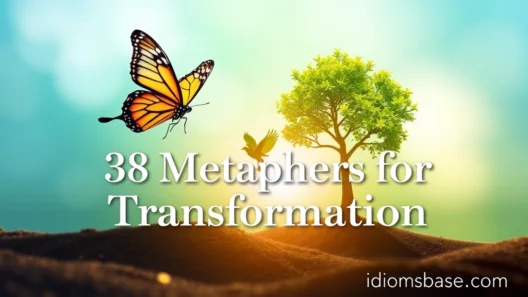Have you ever stopped to think about how we describe something as profound and elusive as "truth"? It’s a concept that has captivated philosophers, poets, and everyday people for centuries. We seek it, we champion it, and sometimes, we even fear it. But how do you put such a vast idea into words? That's where metaphors come in!
Metaphors are like magic wands for language, allowing us to paint vivid pictures and connect abstract ideas to tangible experiences. They help us grasp complex concepts by comparing them to something simpler or more familiar. And when it comes to truth, these comparisons are incredibly insightful, revealing different facets of its nature.
Join us on a delightful journey as we explore 38 brilliant metaphors for truth. Each one offers a unique perspective, helping you see truth in a new light. Get ready to expand your understanding and perhaps even find a new favorite way to describe this powerful concept!
The Unveiling Truth: Metaphors of Revelation
Truth often feels like something hidden, waiting to be revealed. These metaphors capture that sense of discovery and emergence.
- Truth is a light: This is perhaps one of the most common and powerful metaphors. Just as light dispels darkness, truth illuminates ignorance and shows things as they truly are. It guides us, reveals paths, and makes clarity possible.
- Truth is a key: Imagine a locked door, guarding secrets. Truth acts as the key, unlocking understanding and revealing what was previously inaccessible. It grants access to hidden knowledge.
- Truth is a mirror: A mirror reflects reality without distortion. This metaphor suggests that truth simply shows us what is, without bias or embellishment. It’s a direct reflection of existence.
- Truth is a dawn: Like the morning sun rising and chasing away the night, truth emerges gradually, bringing clarity and a new beginning after a period of obscurity. It's a fresh start for understanding.
- Truth is a revelation: This one is almost literal! It speaks to the sudden, often profound, realization of something previously unknown or misunderstood. It's an "aha!" moment of insight.
- Truth is a whisper: Sometimes, truth isn't shouted from the rooftops. It’s a quiet, subtle prompting, often requiring us to listen carefully and tune out the noise to hear it.
- Truth is a seed: Plant a seed, and given the right conditions, it will grow into something tangible. Truth, like a seed, may start small, but it has the potential to blossom into a full understanding.
- Truth is a hidden treasure: Imagine searching for something precious and valuable, buried deep. Truth is often sought after, requiring effort and persistence to unearth its worth.
The Enduring Truth: Metaphors of Stability and Strength
Some metaphors highlight truth's unwavering nature, its ability to stand firm against challenges.
- Truth is a rock: Solid, unmoving, and steadfast. A rock can withstand storms and erosion, just as truth remains firm in the face of doubt or opposition. It's an anchor.
- Truth is a foundation: A strong building needs a solid foundation. Truth serves as the basis for sound reasoning, reliable knowledge, and genuine understanding. Without it, everything crumbles.
- Truth is an anchor: In a stormy sea, an anchor keeps a ship from drifting. Truth provides stability and prevents us from being swayed by false narratives or fleeting opinions.
- Truth is a compass: A compass always points north, offering direction and guidance. Truth helps us navigate complex situations, pointing us toward what is right and real.
- Truth is a constant: Like gravity or the rising sun, truth is always there, unchanging and reliable, regardless of our beliefs or desires. It's a fixed point in a shifting world.
- Truth is an unshakeable pillar: Imagine ancient, massive pillars supporting a grand structure. Truth supports our understanding of the world, unmoving and strong.
- Truth is pure gold: Gold is precious, doesn't tarnish, and holds its value. Truth, similarly, is invaluable, incorruptible, and retains its worth over time.
The Active Truth: Metaphors of Action and Impact
Truth isn't always passive; it can actively shape, challenge, and influence. These metaphors capture its dynamic nature.
- Truth is a sword: A sword can cut through deception and falsehoods, revealing the core of a matter. It can also be used to defend what is right. It's sharp and precise.
- Truth is a fire: Fire purifies, transforms, and burns away impurities. Truth can cleanse misconceptions and refine our understanding, leaving only what is genuine.
- Truth is a river: A river flows relentlessly, carving its path and eventually reaching its destination. Truth moves forward, often overcoming obstacles, and cannot be permanently dammed.
- Truth is a hammer: A hammer can break down barriers or forge new connections. Truth can shatter illusions and build new frameworks of understanding. It's a tool for construction and deconstruction.
- Truth is a magnet: Just as a magnet attracts certain metals, truth has a way of drawing people towards it, or bringing related facts together. It pulls things into alignment.
- Truth is a sculptor: A sculptor carves away excess material to reveal the form within. Truth shapes our perceptions, removing falsehoods to reveal the true essence of things.
- Truth is a challenger: It confronts our assumptions, questions our biases, and pushes us to re-evaluate our beliefs. Truth doesn't always make us comfortable.

The Simple Truth: Metaphors of Clarity and Simplicity
Sometimes, truth is about stripping away complexity to find what is clear and undeniable.
- Truth is naked: This metaphor suggests that truth has no need for adornment or pretense. It stands exposed, unembellished, and pure. It is what it is.
- Truth is a simple fact: It's not complicated or convoluted. It's a straightforward, undeniable piece of information.
- Truth is transparent: Like clear glass, you can see right through it. There's nothing hidden or obscured; it's easy to understand.
- Truth is plain: It's not fancy or decorated. It's direct, unadorned, and easy to grasp, without any hidden meanings.
- Truth is a clear sky: After a storm, a clear sky is open, vast, and unobstructed. Truth brings similar clarity and openness, free from confusion.
The Elusive Truth: Metaphors of Difficulty and Search
Truth isn't always easy to find or grasp. These metaphors highlight its sometimes challenging nature.
- Truth is a distant star: It's always there, but often difficult to reach or fully comprehend. We can see its light, but its full nature remains far away.
- Truth is a wild animal: It can be untamed, unpredictable, and difficult to capture or control. It might flee when pursued too aggressively.
- Truth is a slippery fish: Just when you think you have it, it might slip through your fingers, hard to hold onto or define precisely.
- Truth is a mirage: Sometimes what appears to be truth is merely an illusion, leading us astray. It requires careful discernment.
- Truth is a winding path: It's not always a straight line. The journey to truth can be long, with twists and turns, requiring patience and perseverance.

The Personal Truth: Metaphors of Internal Experience
Truth isn't just external; it can be deeply personal and resonate within us.
- Truth is a feeling: Sometimes, we just "feel" that something is true, a deep sense of conviction that transcends logic alone. It resonates with our inner being.
- Truth is a voice within: It's that inner wisdom, intuition, or conscience that guides us and speaks to us with honesty.
- Truth is a guiding star: While "distant star" emphasizes elusiveness, "guiding star" focuses on its internal role as a beacon that helps us navigate our moral and personal choices.
- Truth is a heartbeat: It's fundamental to life, a rhythm that sustains us, a core part of our existence that we often take for granted but cannot live without.
- Truth is a rooted tree: Like a tree, it grows from deep within, drawing strength from its foundations and standing tall, providing shade and stability. Its roots are in our core beliefs.
- Truth is your authentic self: This metaphor suggests that living truthfully means aligning with who you genuinely are, your true nature, without pretense or masks.
Key Takeaways
- Truth is Multifaceted: There's no single way to describe truth; it encompasses revelation, stability, action, simplicity, elusiveness, and personal experience.
- Metaphors Enhance Understanding: By comparing truth to tangible things, metaphors help us grasp its complex nature more easily and deeply.
- Language Shapes Perception: The metaphors we use to describe truth can influence how we perceive and interact with it.
- Truth is a Journey: Whether it's a "path," a "hunt," or a "growing seed," many metaphors highlight that understanding truth is an ongoing process.
- Truth Has Power: From "sword" to "fire" to "foundation," truth is consistently portrayed as a potent and impactful force.
Frequently Asked Questions (FAQs)

Q1: Why are metaphors important for understanding abstract concepts like truth?
Metaphors are incredibly powerful because they bridge the gap between the abstract and the concrete. When we talk about something as intangible as "truth," it can be hard to grasp. By comparing it to something we can see, feel, or experience – like a "light," a "rock," or a "key" – metaphors make the concept more relatable, understandable, and memorable. They allow us to visualize and connect with the idea on a deeper level, revealing different facets of its meaning that might otherwise remain hidden.
Q2: Can different cultures have different metaphors for truth?
Absolutely! While some metaphors for truth, like "truth as light," are quite universal due to shared human experiences, many others can be deeply rooted in specific cultural contexts, beliefs, and even landscapes. For example, a culture living near a vast desert might use metaphors related to oases or mirages, while a coastal culture might use metaphors involving tides or deep waters. Cultural values, philosophical traditions, and even religious texts heavily influence the metaphors that emerge and gain prominence within a society. Exploring these differences can offer fascinating insights into diverse worldviews!
Q3: How can recognizing these metaphors help me in daily life?
Understanding these metaphors can be incredibly beneficial! Firstly, it enhances your communication skills. When you want to explain something complex about truth, you can choose a metaphor that best conveys your meaning. Secondly, it improves your critical thinking. When someone else uses a metaphor for truth, you can better understand their perspective and the underlying assumptions they might have about truth's nature. It helps you recognize different viewpoints and engage in more nuanced discussions. Finally, it enriches your appreciation for language and its ability to shape our understanding of the world around us.
Q4: Are there any negative metaphors for truth, or only positive ones?
That's a great question! While most common metaphors for truth tend to be positive (e.g., light, foundation, gold), reflecting our desire for and value of truth, some can imply difficulty or even pain in its discovery or acceptance. Metaphors like "a bitter pill to swallow" or "a sharp incision" suggest that truth, while necessary, can sometimes be unpleasant or challenging to confront. The "wild animal" or "slippery fish" metaphors also highlight the difficulty in grasping or containing truth, which isn't necessarily negative but certainly portrays it as elusive. These less "positive" metaphors often reflect the human struggle and discomfort that can accompany genuine understanding.
Q5: How do metaphors for truth relate to the concept of "objective" vs. "subjective" truth?
This is where things get really interesting! Metaphors like "a rock," "a constant," or "a mirror" often align with the idea of objective truth – something that exists independently of our perceptions or beliefs, universally true for everyone. They emphasize stability, universality, and an external reality.
On the other hand, metaphors like "a feeling," "a voice within," or "your authentic self" tend to lean towards subjective truth – something that resonates deeply and is true for an individual, often based on personal experience, intuition, or inner conviction. While objective truth seeks to describe reality as it is, subjective truth often describes reality as it is experienced or understood by an individual. Many of the metaphors bridge these concepts, showing that truth can be both an external reality and an internalized experience.
We hope this exploration of 38 metaphors for truth has sparked your imagination and deepened your appreciation for this fundamental concept. Which metaphor resonated most with you? Do you have a favorite that wasn't on our list? We’d love to hear your thoughts! Share your insights in the comments below and let's continue the conversation about the many wonderful ways we describe truth!






